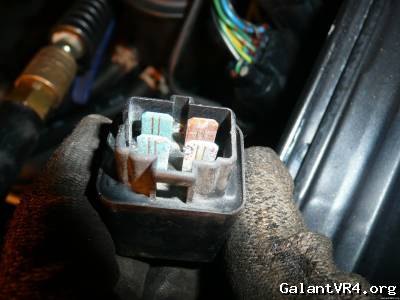... this *may* be one of those times where there's a
definate cause and effect ...
When everything is new and the motor gets full voltage, it'll start up and run just fine.
... after the harness starts to age, corrosion can and will begin in all the terminals becuase of the large current draw of the fan. That big ole honkin fan motor is one of the greediest sum'bitches for power on a car. Just the flow of current accross the terminals will heat them, and then over time, they start to oxidise and it lead to an ever increasing spiral of resistance creating heat creating corrosion, creating resistance which creates more corrosion and so on ...

... till every connection is the system looks like this ...
The poor motor will suffer this indignity for awhile, but then it will start to run hot because it's starved for power, and this will lead to it's eventual demise.
Quoting jepherz:
So am I correct in saying that a stopped fan is essentially a short, and that an older fan with older bearings and older windings will draw more current as well?
^^^ and now we get to the crux of the matter!
That is
exactly true!!!
Anything that inhibits the fan from moving off from a dead stop will increase the start up current substantially.
If the corrosion on the termnials/connections chokes the start up current, it takes longer for the motor to begin rotating, and that will
logrythmitcally increase both the length and current of the start up spike.
Along the way, the current draw will become more than the fuse can take, and
*poof* that's that.
A new motor will "cure" the problem for awhile, but it will lead a short service life if the voltage drop is not addressed.
That said, when troubleshooting this type of circuit, I always check the current draw directly to the fan motor, quick and dirty like, with a fused jumper wire set
before I just condemn the fan motor.
A good choice for a fuse in this case would be one that's rated for five amps
under the usual fuse spec.
Just unplug the fan motor, and use the jumpers to feed it straight from the battery to the motor thru the plug on the pigtail from the motor.
If the fan will run on that set-up, I'll spend some time cleaning up the various terminal/connections. A small metal toothbrush will make short work of this task, and after they are shiny, a little di-electric grease on them will keep them that way.
I'll also check to see what the voltage drop is across the relay. That can be done with a meter, but just feeling if it's getting hot while the motor is running will also tell the tale. Their contacts can and often do get burned by the extra current a dying motor can draw.
Don;t forget the ground side of things, either! /ubbthreads/images/graemlins/wink.gif
Make sure everything is tight and corrosion free there as well.
I only mention this because I've had a few of these silly cars pop that fuse, and after replacing the fan with another that worked fine in another car and still having the fuse pop, I had to look for a cause, and that's what I found.
If after getting things all clean you still gots problems,... then you can pitch the fan with a clear conscience and know the replacement has the best chance for along life.











